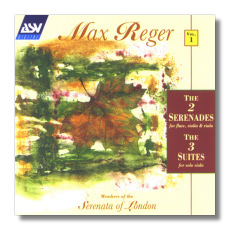
The Internet's Premier Classical Music Source
Related Links
- Reger Reviews
- Latest Reviews
- More Reviews
-
By Composer
-
Collections
DVD & Blu-ray
Books
Concert Reviews
Articles/Interviews
Software
Audio
Search Amazon
Recommended Links
Site News
 CD Review
CD Review
Max Reger

Serenades & Suites
- Serenade for Flute, Violin & Viola in D Major, Op. 77a (1904)
- Serenade for Flute, Violin & Viola in G Major, Op. 141a (1915)
- Suites for Solo Viola, Op. 131d, #1-3 (1915)
Serenata of London
Academy Sound & Vision CDDCA875 DDD 64.28
'Volume 1', a small box on the cover quietly states. Well, if AS&V manage both to get through Reger's copious outout of chamber music and to do it as well as they have done here, we will be well served indeed. This first instalment gives the lie to the ridiculous old saw that Reger's music is heavy, overscored, chromatically complex or some other how unpalatable, for the works assembled here – the two Serenades for flute, violin and viola, and the three Suites for solo viola – offer untrammelled delight from beginning to end.
The Serenades manage to combine a lightness of texture and abundant wit – a characteristic Reger himself had in generous store – with a forward momentum that is rare in such a combination (the example of Beethoven may have helped here). And the viola Suites, although obviously modelled on Bach, don't attempt the seriousness of purpose that much of Reger's other Bach-inspired music for solo stringed instruments does; Reger is content to let the tunes tumble out – into a highly contrapuntal framework, certainly, but one in which melody is the predominant feature. The Suites are all in four movements: a preludial opening movement, a scherzo or slow movement (the order of the two decided as a contrast with the first movement) and a closing moto perpetuo; and the Serenades have a simple fast-slow-fast three-movement structure. The external forms are thus as simple as the music itself – but being by Reger, it is still a source of constant interest: there's always something happening in the textures, some imaginative turn in the part-writing, a new melody emerging and being taken into the weft. This may be Reger in lighter mood, but his inventiveness is in no way abated.
The performances – by the flautist Anna Noakes, violinist Barry Wilde and violist George Robertson – are fine indeed, Robertson finding exactly the right tone for the viola Suites (not too weighty, not too flippant).
I see from the booklet (which has brief but to-the-point notes from Mike George) that Volume 2 will offer the complete Préludes and Fugues for solo violin. Although I shall be awaiting the appearance of that disc with some eagerness, I am hoping too that AS&V get around soon to the two String Trios that each share an opus #with the Serenades recorded here – Op. 77b was my introduction to Reger twenty or so years ago and completely converted me, and I still hold that work in deep affection.
In the meantime, congratulations to all concerned. If those nasty old falsehoods about Reger have held you back in the past, here's where to start – you'll be converted very swiftly.
Copyright © 1994 & 1998, Martin Anderson.
This review originally appeared in CD Review


















